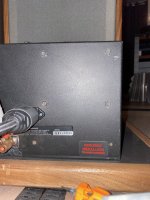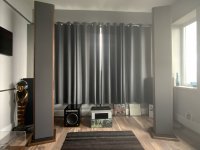I have a pair of 1 + 1s with Red Medallion transformers that were given to me. They sat for a few years unused. I just got a new turntable and cartridge and did some serious listening and noticed something wasn't right. The left and right channel balance didn't sound right while sitting down and listening near field. After listening in mono and up close to each panel, I noticed the right channel lower panel has a reduction of treble, and the left channel upper panel also has a reduction of treble. I switched the transformers and get the same issue, so it appears the panels are the problem. I looked at the wires from the panels and the connections to the speaker wire spades and HV pin to the circuit board look good on both speakers. Listening further away in my usual location still sounds amazing.
What could cause this? Has the output wire from the high frequency transformer come loose from the panel? If so, is there a way to fix this?
Any other possibilities?
What could cause this? Has the output wire from the high frequency transformer come loose from the panel? If so, is there a way to fix this?
Any other possibilities?
I’m thinking that Acoustat Anserman is a member here, right. Andy might be able to help….I have a pair of 1 + 1s with Red Medallion transformers that were given to me. They sat for a few years unused. I just got a new turntable and cartridge and did some serious listening and noticed something wasn't right. The left and right channel balance didn't sound right while sitting down and listening near field. After listening in mono and up close to each panel, I noticed the right channel lower panel has a reduction of treble, and the left channel upper panel also has a reduction of treble. I switched the transformers and get the same issue, so it appears the panels are the problem. I looked at the wires from the panels and the connections to the speaker wire spades and HV pin to the circuit board look good on both speakers. Listening further away in my usual location still sounds amazing.
What could cause this? Has the output wire from the high frequency transformer come loose from the panel? If so, is there a way to fix this?
Any other possibilities?
Though not impossible, it’s highly unlikely you have a bad panel, or a bad connection to the panel. Panels tend to work or they don’t, there’s really no failure mechanism that might affect frequency response. Same for the connection to the interface – it’s a full range signal, so it’s either connected or it’s not.
I think the treble imbalance you notice between panels is due to room acoustics – large planar speakers can do that when you attempt to listen close.
But you did notice a channel imbalance from the listening position, so let’s concentrate on that first. I recommend replacing both the (5) diodes and (5) capacitors in each of the bias multipliers. These parts don’t last forever and replacing them may cure all of your perceived issues. There is no sonic value in substituting higher quality parts here, and they probably wouldn’t fit the board anyway.
I recommend these replacement parts for the bias multiplier. Both can be purchased from www.mouser.com. You'll need ten of each to service one pair of speakers.
Vishay GP02-40 diode, 250 mA, 4000 volts
Mouser p/n 625-GP02-40-E3
Vishay 564R30TSD33 capacitor, 3300 pF, 3000 volts
Mouser p/n 75-564R30TSD33
Be sure the interface circuitry is completely discharged before work. This can be done by either waiting several hours after being unplugged, or you can use an insulated test lead to short the red pin plug to ground. The capacitors are not polarity sensitive and can be inserted either way. The diodes ARE polarity sensitive. Be sure to document the orientation of the original diodes by noting which end is marked (usually with a paint dot). These marks will correspond to the banded end of the new diodes. Be sure all solder connections are good and watch for any stray whiskers of solder that might be bridging parts of the circuit. If you lack the skills or confidence to do the work, any good electronics technician should be able to do the work if you supply the parts.
I think the treble imbalance you notice between panels is due to room acoustics – large planar speakers can do that when you attempt to listen close.
But you did notice a channel imbalance from the listening position, so let’s concentrate on that first. I recommend replacing both the (5) diodes and (5) capacitors in each of the bias multipliers. These parts don’t last forever and replacing them may cure all of your perceived issues. There is no sonic value in substituting higher quality parts here, and they probably wouldn’t fit the board anyway.
I recommend these replacement parts for the bias multiplier. Both can be purchased from www.mouser.com. You'll need ten of each to service one pair of speakers.
Vishay GP02-40 diode, 250 mA, 4000 volts
Mouser p/n 625-GP02-40-E3
Vishay 564R30TSD33 capacitor, 3300 pF, 3000 volts
Mouser p/n 75-564R30TSD33
Be sure the interface circuitry is completely discharged before work. This can be done by either waiting several hours after being unplugged, or you can use an insulated test lead to short the red pin plug to ground. The capacitors are not polarity sensitive and can be inserted either way. The diodes ARE polarity sensitive. Be sure to document the orientation of the original diodes by noting which end is marked (usually with a paint dot). These marks will correspond to the banded end of the new diodes. Be sure all solder connections are good and watch for any stray whiskers of solder that might be bridging parts of the circuit. If you lack the skills or confidence to do the work, any good electronics technician should be able to do the work if you supply the parts.
I have the same speakers: interfaces are stock red medallion. Would I be wise to do this? I don’t hear any specific problems, but as you say, these parts don’t last forever. Thanks,I recommend these replacement parts for the bias multiplier. Both can be purchased from www.mouser.com. You'll need ten of each to service one pair of speakers.
Vishay GP02-40 diode, 250 mA, 4000 volts
Mouser p/n 625-GP02-40-E3
Vishay 564R30TSD33 capacitor, 3300 pF, 3000 volts
Mouser p/n 75-564R30TSD33
m.
Attachments
I'm a big fan of not fixing things until they are broken. Your parts may have many years to go. But a happy compromise is to buy the parts now so you'll have them on-hand if they ever go bad. A small investment.I have the same speakers: interfaces are stock red medallion. Would I be wise to do this? I don’t hear any specific problems, but as you say, these parts don’t last forever. Thanks,
m.
I installed the new bias supply parts, I did have to substitute a Vishay cap at 20% tolerance as the others were backordered. After 12 hours being energized, I listened and there might be a slight improvement in dynamics, but I don't have much in test equipment anymore to prove it. A friend who also owns 1 + 1s who has been helping me sort this out had the same impression. Using an app on my iphone and pink noise did show that the Left channel lower panel was 4 dB louder than the upper panel. The Right channel upper panel was 2 dB louder than the lower panel. I moved the speakers to the middle of the room and measured them all at the center of each panel at 12" to avoid room interaction as much as possible. I wish I had a better test setup, but the measurements I did get coincide with what my ears tell me. I think what I perceived as a lack of treble between panels is actually just related to a lower volume. The channel imbalance is still noticeable listening nearfield, but not as noticeable farther away. To eliminate the pre and power amp from the problem, I swapped preamp and power amp channels and the imbalance stayed with the speakers.Though not impossible, it’s highly unlikely you have a bad panel, or a bad connection to the panel. Panels tend to work or they don’t, there’s really no failure mechanism that might affect frequency response. Same for the connection to the interface – it’s a full range signal, so it’s either connected or it’s not.
I think the treble imbalance you notice between panels is due to room acoustics – large planar speakers can do that when you attempt to listen close.
But you did notice a channel imbalance from the listening position, so let’s concentrate on that first. I recommend replacing both the (5) diodes and (5) capacitors in each of the bias multipliers. These parts don’t last forever and replacing them may cure all of your perceived issues. There is no sonic value in substituting higher quality parts here, and they probably wouldn’t fit the board anyway.
I recommend these replacement parts for the bias multiplier. Both can be purchased from www.mouser.com. You'll need ten of each to service one pair of speakers.
Vishay GP02-40 diode, 250 mA, 4000 volts
Mouser p/n 625-GP02-40-E3
Vishay 564R30TSD33 capacitor, 3300 pF, 3000 volts
Mouser p/n 75-564R30TSD33
Be sure the interface circuitry is completely discharged before work. This can be done by either waiting several hours after being unplugged, or you can use an insulated test lead to short the red pin plug to ground. The capacitors are not polarity sensitive and can be inserted either way. The diodes ARE polarity sensitive. Be sure to document the orientation of the original diodes by noting which end is marked (usually with a paint dot). These marks will correspond to the banded end of the new diodes. Be sure all solder connections are good and watch for any stray whiskers of solder that might be bridging parts of the circuit. If you lack the skills or confidence to do the work, any good electronics technician should be able to do the work if you supply the parts.
I searched this forum and found a person who was an Acoustat dealer and he said smoking kills the panels. The previous owner was a heavy smoker, I had to remove and wash the speaker cloth as it was brown from the smoke at the top and the bottom of the panels.
Is it possible the smoke has affected the panels? Any other ideas?
Thanks for your help, Chuck
- Home
- Loudspeakers
- Planars & Exotics
- Acoustat 1 + 1 High Frequency Output From Panels

